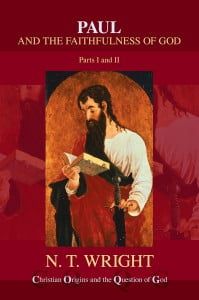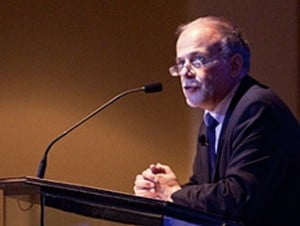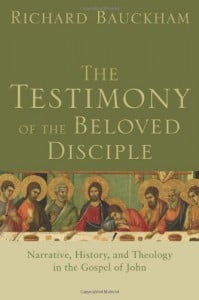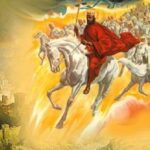 To my dear reader: I wonder if I could tempt you to reach for your copy of Paul and the Faithfulness of God by Tom Wright. (Don’t worry—just let that door close.) Turn with me, if you will, to page 1032, section (j) entitled ‘What then about Torah?’. Make a note of the first letter of the first word of each paragraph through to the end of the section on page 1037. Do you notice anything? Does it make sense to you? And here’s the interesting question: would you have noticed this if I hadn’t pointed it out to you?
To my dear reader: I wonder if I could tempt you to reach for your copy of Paul and the Faithfulness of God by Tom Wright. (Don’t worry—just let that door close.) Turn with me, if you will, to page 1032, section (j) entitled ‘What then about Torah?’. Make a note of the first letter of the first word of each paragraph through to the end of the section on page 1037. Do you notice anything? Does it make sense to you? And here’s the interesting question: would you have noticed this if I hadn’t pointed it out to you?
On this, I recently received an email which might make sense of what you have found:
Tom preached at my father’s funeral a year ago, and was revising this particular section when I rang to tell him. It’s rather beautiful as a way of remembering, the more so for being hidden.
My guess is that this is not the first, nor only, ‘hidden’ feature of Tom’s books. I think it has been fairly widely noted that the two volumes of PatFoG comprise 16 chapters, of which chapters 9 to 11 are, by Tom’s admission, are the centre of the argument. Does that remind you of anything?! And Tom has been at it before. I am reliably informed that there is a similar acrostic reference to his godmother from p 125 of Jesus and the Victory of God. I suspect there are many other things hidden away, and that somebody will have fun tracking them all down.
 We might then ask: if Tom Wright can hide things in his text, could the biblical authors not do the same? The idea of ‘hidden codes’ in the Bible got a bad press a few years ago with the publication of The Bible Code. Michael Drosnin argues that you can rearrange the letters of the Hebrew text of the Bible, and by computer search, find all sorts of ‘predictions’ of world events in history. This was completely unconvincing for several reasons. First, since Hebrew has (in the strict sense) no vowels, you could find almost anything you liked. Secondly, it was therefore clear that this was not something in the text itself, but in Drosnin’s mind. If I rearrange the letters of anything I am reading, I can find whatever I am seeking. So what? The third, more significant point, is that this was not part of the intention of the author in writing, and would not have been understood by readers—so is not, in fact, part of the communicative function of the text.
We might then ask: if Tom Wright can hide things in his text, could the biblical authors not do the same? The idea of ‘hidden codes’ in the Bible got a bad press a few years ago with the publication of The Bible Code. Michael Drosnin argues that you can rearrange the letters of the Hebrew text of the Bible, and by computer search, find all sorts of ‘predictions’ of world events in history. This was completely unconvincing for several reasons. First, since Hebrew has (in the strict sense) no vowels, you could find almost anything you liked. Secondly, it was therefore clear that this was not something in the text itself, but in Drosnin’s mind. If I rearrange the letters of anything I am reading, I can find whatever I am seeking. So what? The third, more significant point, is that this was not part of the intention of the author in writing, and would not have been understood by readers—so is not, in fact, part of the communicative function of the text.
Recognising these problems is not a reason for writing the idea off altogether. In an excellent set of studies on Matthew from the Tyndale Study Group, Built Upon a Rock, Stephanie Black notes that language is not very efficient in communicating. Alongside the information conveyed by language is a whole lot of other stuff which is not strictly necessary. This of course explains why we manage to communicate in the abbreviated form of things like text messages and Twitter. This additional, unnecessary stuff gives language its style, its personality and its nuance—which is why abbreviated communication can sometimes be misleading! She then looks at how Matthew uses this ‘surplus’ in his distinctive style—but it could be use to hide codes of various sorts, and in particular, numerology.
It is reasonably well-established that the Book of Revelation uses numerology fairly extensively. I am quite surprised when some even recent commentators remark on Rev 13.18 ‘We should not treat this as a code.’ It really does look as though the author intended us to! In fact, Revelation uses numerology in three distinct ways:
- Gematria (the Hebrew term) or isopsephism (the Greek term), where the numerical value of letters and words has significance, usually by identifying two words or phrases that have equal value.
- The mathematical feature of numbers as square (144), triangular (666) or rectangular (42).
- Word frequencies, where significant terms occur a certain number of times throughout the work.
 Go to chapter 11 of Richard Bauckham’s The Climax of Prophecy or the summary and my own comment in my Grove booklet How to Read the Book of Revelation to find out more. Richard has also done extensive work looking at the numerical literary features of John’s gospel, particularly in relation to the significance of the 153 fish in John 21, which he published as the last chapter in his collection of essays The Testimony of the Beloved Disciple. Here, he notes that much work has been done on numerical literary features, but it has often been by-passed and its significance ignored. He highlights some remarkable features of John’s gospel:
Go to chapter 11 of Richard Bauckham’s The Climax of Prophecy or the summary and my own comment in my Grove booklet How to Read the Book of Revelation to find out more. Richard has also done extensive work looking at the numerical literary features of John’s gospel, particularly in relation to the significance of the 153 fish in John 21, which he published as the last chapter in his collection of essays The Testimony of the Beloved Disciple. Here, he notes that much work has been done on numerical literary features, but it has often been by-passed and its significance ignored. He highlights some remarkable features of John’s gospel:
- The prologue (John 1.1–18) consists of 496 syllables. 496 is both a triangular number and a perfect number—and it is the numerical value of the Greek term monogenes (‘only’) in John 1.14 and John 1.18.
- The next section, from John 1.19 to John 2.11, consists of 1550 syllables, which is the value of the phrase ho Christos, (‘The Christ’).
- Jesus ‘high priestly prayer’ to the Father in John 17.1b–26 consists of 486 words, and 486 is the numerical value of pater (‘father’).
Having noted these, Bauckham adds a fourth of his own:
- The numerical value of ‘Jesus’ in Hebrew is the same as the numerical value of ‘Lamb of God’ in Hebrew, 391. So when John the Baptist proclaims ‘Behold, the Lamb of God!’ in John 1.29 and John 1.35–36, he is doing gematria with Jesus’ name.
These are unusual ways of reading the text; if you warm to these observations it probably says something about you! Many simply find them baffling—but the key question is: could John have done this in his writing? At each stage, Bauckham is careful to note that only certain terms appear to have numerical significance, and he also supports this approach by observing its historical plausibility:
It may be that some aspects of numerical composition were not expected to be directly discerned by readers, but were thought to give appropriate form to the text, as ways of conforming the lengths and proportions of the text to its meaning. But we should remember that counting the number of syllables or words in a text was not as unfamiliar an activity then as it is now: it was regularly done to determine the price of manuscripts and for scribes to check the accuracy of their transcriptions.
And he points out that not seeing these patterns does not detract from the meaning of the text for ordinary readers. Unlike the Drosnin Bible Code approach, these hidden patterns support the more obvious sense of the text rather than contradicting it or saying something completely unrelated.
(Now Richard and I have recently had some more correspondence on this subject. I pointed out to him a gematria I had come across, where ‘the Son of Man’ in Hebrew has the same value as ‘serpent’, both equal to 558. Richard looked further and found similar gematria for four other of the 12 occurrences of ‘The Son of Man’…which is why he is a Fellow of the Royal Society and I am not!)
 Does this have significance for biblical scholarship? Yes, argues Bauckham. It demonstrates that, contrary to decades of scholarship, John’s gospel and the Book of Revelation were not the result of successive editing processes and composition by a series of writers, but were the product of careful composition by an individual. The difficulty here is that many people already have a vested interest in theories of composition through their own research—so they are going to take some persuading. But the data looks rather impressive to me.
Does this have significance for biblical scholarship? Yes, argues Bauckham. It demonstrates that, contrary to decades of scholarship, John’s gospel and the Book of Revelation were not the result of successive editing processes and composition by a series of writers, but were the product of careful composition by an individual. The difficulty here is that many people already have a vested interest in theories of composition through their own research—so they are going to take some persuading. But the data looks rather impressive to me.
More, than this, these kind of insights to have an impact for ordinary readers. It suggests that many texts of the New Testament were composed with extraordinary care—and so they should be read very carefully in their turn. Alongside reading longer passages, perhaps the practice of concentrating on and memorising smaller portions isn’t so bad after all.
Eventually, you might even spot the secret message hidden in this blog post!
Additional note: There is another rather nice example of an acrostic code in this US local paper leader on Kirby Delauter which went viral on Twitter for a while.
I work freelance. If you have valued this post, would you consider donating £1.20 a month to support the production of this blog?




























Well done to David Mosley who spotted it…and I have deleted his answer so as not to spoil for others!
Ha! Well done! I actually thought I saw another pattern which initially threw me…
J
I’m intrigued…
The capital letters of the enboldened sentences hinted at the word ‘wisdom’
J
That’s interesting…but doesn’t in fact actually work. This rather illustrates one of the points in the discussion below: are such things actually there?
When you find it, you will know. Richard Briggs’ comment gives a good clue!
Margaret Barker would be happy with all of this until your conclusion about editing. Looks like you’ve made a powerful enemy! Look out, Ian!
Really? I am surprised. She likes codes, but I think she does not discern what is actually in the text, and what she reads into it, or imagines is there. I think she is subject to the kind of parallelomania that Richard quite carefully avoids. His proposals are, I think, disciplined by both the text and the historical context.
Thanks – informative, entertaining and playful all in one.
I would caution against coming to any conclusions about these numerical phenomena in John’s gospel until a proper statistical analysis has been done. Only careful mathematics can tell us whether the observations are significant or coincidental. Unfortunately NT scholars are, in general, notoriously bad at statistics, and Bauckham himself has admitted on the internet that he is no statistician. Indeed, Goodacre spotted a statistics blunder in his work a few years ago. Unfortunately the chapter of “The Testimony of the Beloved Disciple”, to which you refer, attempts no statistical analysis, so Bauckham’s conclusions are premature.
Richard, do tell me more about this. Richard B is actually (at the points I mention) citing a 1985 (I think) PhD thesis on this, so there has been plenty of work on it—it is not just being picked out of the air. At some other points, he is careful to explore terms which *don’t* appear to have significance.
I agree with you (as a mathematician myself) that a fuller analysis needs to be done, and in correspondence with Richard have suggested ways of doing that, along with suggesting to him the kind of critical questions people will ask about ‘the Son of Man’ in John. I am most familiar with his work on Revelation, and I think his results really do stand up to scrutiny there.
Can you tell me more about Mark G’s criticism? Is it available somewhere?
Actually, I’ve been chatting with Mark. He doesn’t think the numbers actually work, and considers it speculative.
In fact, I’ve counted the syllables in NA27 and I think they are right, and similarly with the 496 words that Richard B cites as the length of the epilogue. Mark has missed an important textual note that Richard makes.
What further statistical analysis would you like to see?
Mark G does point out that Menken is building on a previous work by Irigoin. In fact, he was correcting him, and you can actually read the critique on the Google book version of Menken’s thesis, pp 19-20
Ian, the statistical blunder by Bauckham that I referred to concerns the frequency of name combinations and can be found here. Even Goodacre himself got a little muddled here. I should add that I have benefited greatly from Bauckham’s work and I have no reason to suppose that his mathematical abilities are worse than those of the average NT scholar. Bauckham at least attempted to calculate the statistics. The neglect of statistics is a much more frequent crime in NT studies. A recent NTS paper on the frequency of the name “Erastus” gave the numbers of men with that name, but neglected to give the size of the parent population! It is shocking that no-one spotted this omission prior to publication. Even though NT studies rarely involves mathematical calculations, as such, the kind of logical thinking involved in maths is essential for many aspects of the discipline. So I am encouraged to learn that you are a mathematician.
Anyway, I have not read widely on symbolic numbers in John’s gospel so I am at a disadvantage here, but I did read the pages from Menken’s thesis that you mentioned. From the little that I have read, it seems that those who see significance in these matters give themselves a large number of degrees of freedom. Numbers are deemed significant if they are triangular or square or correspond to a name or concept that is relevant to the text. They can count syllables and words. They can count them in passages or in sentences. There is also freedom in delimiting the passages/sentences and in deciding what counts as a syllable and in deciding which words were in the original text. Given the large number of passages in the NT, it seems to me that chance alone will guarantee that some of them will throw up some word count (or whatever) that appears to be symbolic in some way.
What we need is a clear thesis statement and a statistical test to assess it. For example, if someone found that other writers of the period tended to prefer triangular sentence word counts, a thesis statement could be “NT writers, too, preferred to write sentences with triangular word counts”. We could then count the number of triangular sentence word counts in the NT and calculate the probability that this number or more could happen by change. If this probability is greater than the proportion of other authors who prefer triangular numbers, then we have an interesting result.
I read the (very brief) section on statistics at the end of Menken’s work, but found nothing there to convince me that his results are statistically significant.
I’m not saying that any of the proposed phenomena are necessarily illusory. I am only saying that it needs to be shown that the probability that a phenomenon will happen by chance is less than the strength with which the phenomenon is attested by external data (e.g. the frequency with which other writers exhibit the phenomenon).
I think that’s quite impressive.
And another thing:
Nobody would have spotted this without help
Save for a few strange individuals, perhaps.
But overall, I think I have to say that,
Love or hate this kind of mathematical and linguistic wizardry
One over-riding conclusion is:
Get out more!
Ha ha ha ha! Very funny! Does that mean I should now stop counting syllables to see with Richard B or Mark Goodacre is right?
But the irony is that I heard about the NTW code whilst I was out in Cambridge. See what you missed out on!
Here’s another remarkable feature pointed out by Menken (though not discovered by him):
There are also several instances of isopsephia in Acts, where the number of syllables of an episode or speech is equal to the numerical value of an important name or word occurring in or related to the passage in question (such as we found concerning John 1.1-18, where both the number of syllables and the numerical value of monogenes are 496). Peter’s speech in Acts 2.14-b-36 is made up of two equal halves: 444 syllables in 2.14b-24, and again 444 syllables in 2.25-36. Their sum, 888, is the numerical value of the name Iesous, a number which was famous in this quality in the second century, witness Irenaeus’ Aversus Haereses 1.15.2.
The NT is about 300 times longer than this passage, so it is not so surprising that one passage would have 888 syllables, is it? By the way, the idea that Luke went to the trouble to count words would not sit comfortably with Goodacre’s belief that he was not diligent enough to avoid exhibiting “fatigue”. I imagine that Goodacre and Bauckham have very different assumptions about how the gospel’s/Acts were written.
Richard, thanks for the comments and the link. I am not the statistical problem really relates to this example.
But more generally, the kind of statistical analysis you are suggesting doesn’t answer the question. To take my NTW example, let’s do a statistical analysis of all his works and find out how many times he includes acrostic clues. Suppose the answer is ‘Two’. What does that tell us?
In Acts 2, it is quite striking that the speech is bipartite, in that it tells the story of what God has done in Christ twice, the first time ending with the resurrection, the second with the ascension and gift of the Spirit. This ties in with Luke’s use of doubling, for instance relating miracles in pairs of male/female, and the depiction of Peter and Paul’s ministry in fairly strict parallel.
So the analysis of syllables in these two parts looks significant. It would be if this were the only place Luke does this, or if he does this on other occasions too.
Statistically, if the two acrostics I mentioned in NTW were the only ones he ever did, it would not make them less likely. We need to appeal to other criteria.
Concerning your Wright example, we would need to calculate the probability that a work of such length could, by chance, give equally strong evidence of deliberate acrostics. If the two hypothesized acrostics that you mention are such that could not reasonably have occurred by chance, then, yes, we need not worry that there are no others. If, however, they were not so strong, we would need to factor in the lack of acrostics elsewhere in the text. That is to say, we would need to account for the “misses” as well as the “hits”.
Returning, then, to your Acts 2 example, 888 is not such a huge number, so we need to count all the “misses”. Given the large number of degrees of freedom, the number of misses is large. Your point that the Acts 2 passage is just where we might expect a significant word/syllable count is valid of course, but are there not many many other passages in the NT whose word/syllable counts would have been equally impressive if the numbers had come out right?
I have just read Bauckham’s thoughts on number symbolism in revelation. He suggests that squares are good and triangles are evil. How does he reconcile this with his view that 153 in John’s gospel is a deliberate triangle?
Richard, it has occurred to me that it is quite easy to answer your question.
There are 24 speeches in Acts (that in itself it interesting!). I haven’t counted their length, but suppose they are between 500 and 1000 words or syllables.
I guess there might be five numbers that could be seen as ‘significant’ such as 888, 1260, 1000, 153 and so on–but not many more.
At a rough calculation, that would suggest that there is only 1% chance of a speech have a special length ‘by accident’. So there is a prima facia case for taking note of this.
I am just writing a new blog entry on a related point.
24 speeches in Acts. 5 significant numbers. One with 888 words is a “hit”. The chances of this are 24*5/888 = 14%, not 1%.
Also, I am not convinced that you have cast your net wide enough in search of “misses”. What about passages other than speaches? What about syllable counts as well as word counts? etc.
Regarding the probability of any of the 24 speeches having a “special” number of words/syllables just by chance, you don’t multiply by 24. You need to work out the probability of none of them having a special number of words or syllables and subtract this from 1. Using the figures mentioned in other comments, this would be 1-(883/888)²⁴ which is about 12.7%. Unlikely but not super-unlikely.
Looking at it another way, you would need to have around 180 speeches of this length before you would expect one of them to have a special number of words/syllables.
All of this ignores the fact that the length of speeches is highly unlikely to be uniformly distributed between the shortest and longest, which makes all of the above calculations meaningless.
I still think at least some of it was intentional, though.
Thanks—that is really helpful. You are quite right—that is the correct way to do the calculation.
What are Mark’s comments about ‘fatigue’?
Goodacre has written on “fatigue” here. Actually I was wrong to suppose that Mark believes that the gospel writers did not go to much trouble. See his answer to my comment here. I don’t buy his analogy with continuity errors, which are much harder to avoid than the kind of slips that Goodacre supposes the gospel writers made. But I am not drifting off-topic.
Interesting that he characterises these as ‘fatigue’. The other option is that they assumed people would also be reading the account that they have read.
This is certainly how Bauckham construes similar things in John. Is it ‘fatigue’ that makes John fail to mention Jesus’ actual baptism in John 1? Don’t think so.
But I do agree with his main point: there is no Q, since we can explain the interrelation better without it.
Interesting stuff. I’m convinced by some of Bauckham’s John discoveries and a fan of Wright’s use of biblical compositional techniques in his work. As it happens I made a video on gematria and number symbolism in the Bible last week after we had a lot of interest in a previous video on the subject of 666 (perhaps not surprisingly for YouTube!). Have you come across Labuschagne’s work on ‘Numerical Secrets’ and discussion of the structuring principle of 26 as the number of YHWH?
Can you give the link to your video? Yes, I have downloaded Labuschagne’s book but not spent very much time on it. When I dipped in, I was in Richard Fellows’ position and wondering how to avoid seeing numbers everywhere, even if they weren’t there…
Yes, it does feel very much like a kind of arithmania overall with Labuschange, but I think there is something to be explored further in relation to 26 in particular. I’m not sure when my video will appear – or what exactly it will cover(!) We filmed for over half an hour, but the video will be around 10mins.
Bauckham is right that Day 1 of the initial week is MONOGENES, counting by syllables.
I think John has 2 groups of 3 days in chapter 1. 3 John the Baptist days (MARTURIA/MARTUS) followed by 3 disciple days (MATHETAI). He therefore puts MARTURIA and MATHETAI, which are themes that cover groups of 3 days, in the middle of those 3 days, and gives one-third of their total syllables, to indicate that these 2 words MARTURIA and MATHETAI span the whole range of 3 days not just 1.
TOTAL of Days 1-3 (John 1.1-34): 1041 = MARTUS
TOTAL of Days 4-7 (John 1.35-51, 2.1-11): 1000 (4-7 are concerned with enumeration and numbers that are interesting in their own right).
1 (496) MONOGENES
2 (317) one-third of MARTURIA (952)
3 (228) ERGON (the theme here is Jesus’s great climactic Good Friday and Easter works as Lamb, Man, and King)
4 (164) HEMERAI (John makes a plural day here out of days 4-5 by failing to say ‘the next day’ for Day 5)
5 (123) one-third of MATHETAI (369). 1-2-3 also counts the number of disciples so far.
6 (349) ISRAEL (half the appearances of ‘Israel’ &c. in John come here). John may think 349 like 6 is a falls-short number. Falls short of 7 jubilees.
7 (364) number of days in the year (by Qumran and Jubilees and a widespread contemporary reckoning that gave an even number of weeks). ‘Year’ is key to 2.1-11 because of the jubilee themes of plenty out of lack, new beginning.
Taking Mathetai as 369, the last 4 numbers are similar and can change into one another in single steps in the following sequence: 164-364-369-349.
(I am more doubtful whether John intended to have 496 words in 21.1-23 as Bauckham reckons.)
2.1-13 is 432 PANTA (John employs 432 pattern elsewhere).
Days 4-6 above (Jn 1.35-51) total 636 PANTES.
Full list is as follows. Each ‘hidden’ Greek word is discovered by a syllable count of each calendar day in John 1-2. The number of syllables equals the numerical value of the common Greek word that is discovered.
These words turn out to be the headings, in order, of the 9 matrices that provide the content for John’s gospel (as circulated at TNTC 2019).
This is a ninefold sequence. John has a device to make it also sevenfold, namely to make it not only 3 lots of 3 but also 3 lots of 1+0.333+1, which totals 7. He does this by making the number of syllables on each middle day (Days 2, 5,8) precisely one third of the value of the word he is hinting at.
Days 1-3 have capitalised words that are singular entities.
Days 4-6 have capitalised words that are plural entities.
Days 7-9 have capitalised words that are totalities.
(Days 1-3) MARTUS (1041 syllables)
(Day 1: 1.1-18) MONOGENES (496) – as Menken, Bauckham
(Day 2: 1.19-28) MARTURIA (317 is one third of 952) [virtually]
(Day 3: 1.29-34) ERGON (228)
(Days 4-6) PANTES (636 syllables)
(Day 4: 1.35-39) HEMERAI (164)
(Day 5: 1.40-42) MATHETAI (123 is one third of 369)
(Day 6: 1.43-51) ISRAEL (349)
(Days 7-9) 700 [number of totality]. Matrices 7-9 are the only ones where each item is of the same nature: (7) numbers; (8) names; (9) Scriptures.
(Day 7: 2.1-11) 364: totality of Days in a Johannine Year (as Jubilees, Qumran)
(Day 8: 2.12) HAPAN [sc. ONOMA: matrix 8 is names/titles] (44 is one third of 132)
(Day 9: 2.13-22) PASAI [sc. GRAPHAI: matrix 9 is Scriptures] (292).
There is therefore a 3-3-3 pattern; but also a 1-5-3 pattern (cf. fish) with a title for each of the Trinity. GEORGOS (Days 2-6) is flanked by MONOGENES (Day 1) and by PANTA [432] (Days 7-9 = 2.1-13). For this purpose, John has 2 versions of Day 9 (break between 2.13 + 2.14) since it is clear that 2.13 follows upon 2.12, but not clear whether or not 2.14-22 is part of the same time-period as 2.13.
Thus of the 14 capitalised words, there are four PAS-PASA-PAN words including all 3 genders, and two totality-numbers.
MONOGENES [1 day] -GEORGOS [5 days] -PANTA [3 days] also summarises the creational states/stages. First day sees primal unity (John 17.5). Days 2-6 see the creation of the earth stage by stage (ge-orgos means maker of the earth). From after the end of Day 6 we have a state of ‘panta’ as Gen 1.31 puts it.
I suspect that for Day 8 John has PAN not HAPAN in mind – this is more Johannine and is more natural and common – the title words are always the most natural and common that come to mind. (Also PAN ONOMA is from Php and Eph, and John is very into Eph.) This would mean that there is an overall internal pattern among the 3 ‘middle’ days of Day 2: when we treble them MARTURIA is one third of a unit over (317×3=951, but MARTURIA is 952), MATHETAI is spot on (123×3 = 369 which is the value of MATHETAI), and PAN is one third of a unit under (44×3 = 132 but PAN is 131); but none of that affects the overall total, and each of these 3 syllable counts remains one third of the title-word’s syllables (to the nearest number). This hook-and-eye / clip-fastener pattern links the whole in a clunk-click manner, a bit like (Mk 15-16) ‘Mary the mother of Joses’ becoming ‘Mary the mother of James’ – it’s a literary inclusio device.
On reflection, John is creating in Jn 1-2 a paean to thirds and sets of 3 [ranging from the largest to the smallest scale], being one of those ancients who appreciate .333recurring specifically for its *eternity*. He goes for 3s in a big way in Jn 1-2 and Rev 1, yet rarely later in these volumes. Mostly the 3 patterns are found in contexts emphasising the divine (or divine architecture), and 3-in-1 is part of what they are saying (e.g. one part of a 3 will itself be divided into 3).
In summary of John 1-2:
The structure is 3×3 days. One third of this is therefore 3.
One third of the days [which appear at intervals of 3] are different in that they have…
…one third of the syllables of their keyword (rather than the full complement);
and these 3 keywords are also a paean to 0.333recurring, since the first overreaches by 0.333, the second is on a level, and the third underreaches by 0.333 (thus: one-third, two-thirds, and three-thirds are all equally represented).